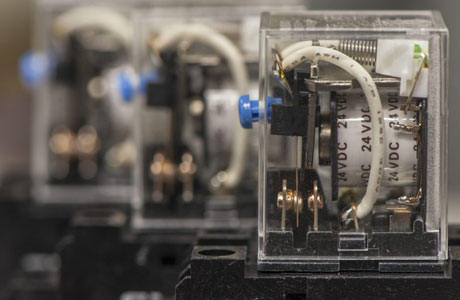Key Takeaway
A relay module is a relay mounted on a board with additional components for isolation and protection. This setup makes it easier to use in various applications. Relay modules are convenient for controlling electrical equipment remotely. They provide a simple way to manage devices like lights, motors, and other systems. By using a relay module, you can safely and efficiently control high-voltage equipment with low-voltage signals, ensuring better performance and safety.
Components of a Relay Module
A relay module typically consists of several key components. The primary component is the relay itself, which acts as the switch. Alongside the relay, there is usually a driver circuit that controls the relay coil, ensuring it can be activated by a low voltage signal. This driver circuit often includes transistors or optocouplers for isolation. Additionally, relay modules may have protection diodes to prevent voltage spikes, terminal blocks for easy connections, and indicator LEDs to show the relay’s status. Understanding these components helps in diagnosing issues and ensuring proper functionality of the relay module in your systems.

Types of Relay Modules
Relay modules come in various types, each designed for specific applications. Common types include single-channel and multi-channel relay modules. Single-channel modules control one device, making them suitable for simple applications like turning a single light on or off. These modules are easy to use and ideal for straightforward tasks. Multi-channel modules, on the other hand, can control multiple devices simultaneously, which is ideal for more complex systems such as home automation where you need to control multiple lights, fans, or appliances from a single control unit.
There are also solid-state relay modules, which use electronic components instead of mechanical contacts. These modules offer faster switching speeds and longer lifespans due to the absence of moving parts, making them perfect for applications requiring high-speed operations and reliability, such as industrial automation and precise control systems. By selecting the appropriate type of relay module, you can tailor the control system to meet the specific needs of your project, ensuring efficiency and reliability in your application.
You May Like to Read
Applications of Relay Modules
Relay modules are incredibly versatile and find applications in various fields. In industrial automation, they are used to control machinery and process systems, ensuring efficient operation and safety. For example, relay modules can manage the start and stop sequences of motors, control conveyor belts, and handle other critical operations in manufacturing environments. In home automation, relay modules can manage lighting, heating, and security systems. They enable smart home systems to turn lights on or off, adjust thermostats, and control security cameras, enhancing convenience and energy efficiency.
In automotive systems, relay modules are used to control lights, motors, and other electrical components. They ensure the proper functioning of headlamps, windshield wipers, and power windows, contributing to vehicle safety and comfort. Additionally, relay modules are crucial in telecommunications and computer networks for controlling signals and data flow. They manage the routing of data packets, control network switches, and ensure stable communication in complex network infrastructures. Understanding these applications helps you see the wide range of possibilities that relay modules offer, making them a vital component in numerous systems.
Advantages of Using Relay Modules
Using relay modules offers several distinct advantages that are invaluable in various applications. One of the primary benefits is electrical isolation. Relay modules isolate low power control circuits from high power loads, preventing potential damage and ensuring the safety of sensitive electronics. This isolation is crucial in protecting microcontrollers and other control systems from voltage spikes and surges that could cause failures.
Another significant advantage is the ability to control high voltage devices with low voltage signals. This capability is essential in many control systems where a low voltage control signal from a microcontroller or PLC can switch high power devices like motors, heaters, or industrial machinery. Relay modules provide the versatility needed to integrate into diverse systems, whether in industrial automation, home automation, or automotive applications. Additionally, they are generally cost-effective and easy to replace, making maintenance straightforward and minimizing downtime. These benefits make relay modules an attractive choice for engineers aiming to design reliable, efficient, and safe control systems.
Installation and Configuration
Proper installation and configuration of relay modules are crucial for ensuring optimal performance and longevity. Start by securely mounting the relay module in a location that is protected from environmental factors like moisture, dust, and extreme temperatures. A well-protected environment prevents premature wear and failure of the module. Next, connect the control signal to the input terminals, ensuring that the voltage levels match the module’s specifications. Incorrect voltage can lead to malfunction or damage, so it’s essential to verify these connections.
After setting up the input, connect the output terminals to the load, ensuring that the load’s current and voltage requirements are within the relay’s ratings. Exceeding these ratings can damage the relay and the connected equipment. Additionally, configure any additional settings such as jumpers or dip switches according to the manufacturer’s guidelines. These settings often control critical parameters like input signal type or output behavior. Following these steps ensures that your relay module operates reliably and efficiently, providing the expected performance and extending its service life. Proper installation and configuration are the foundation of a dependable and safe relay system, crucial for any newly joined engineer to master.
Conclusion
A relay module is a powerful tool in the arsenal of modern electrical engineering. Understanding its components, types, applications, advantages, and proper installation techniques is essential for anyone looking to implement reliable control systems. For newly joined engineers, mastering these concepts is crucial for designing and maintaining efficient and safe electrical systems. With this knowledge, you can leverage relay modules to enhance the performance and reliability of your projects, ensuring success in a wide range of applications.
